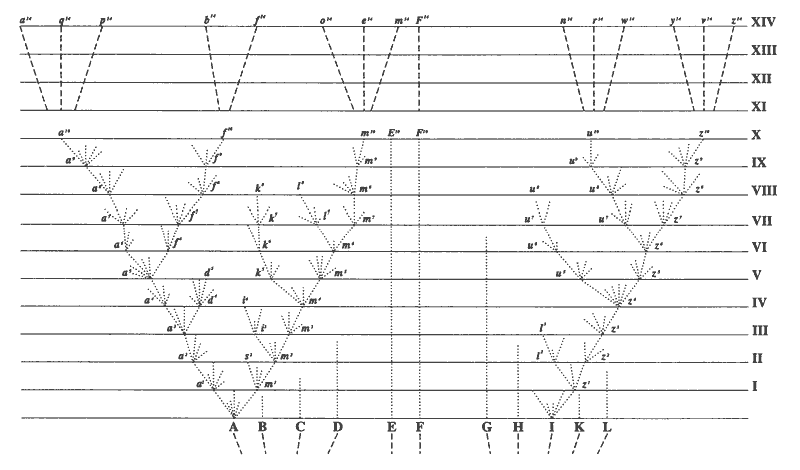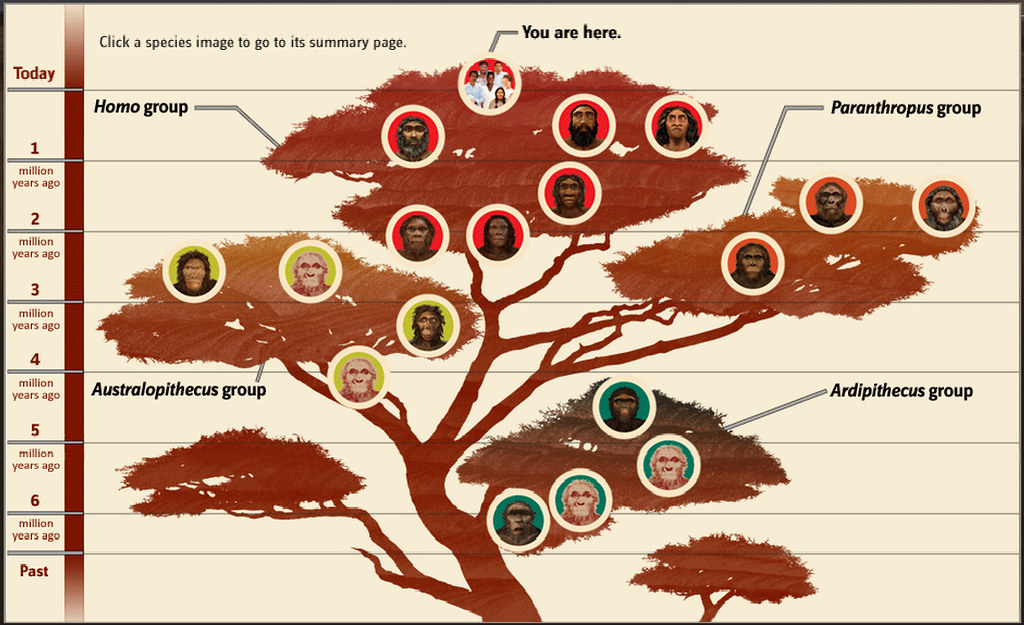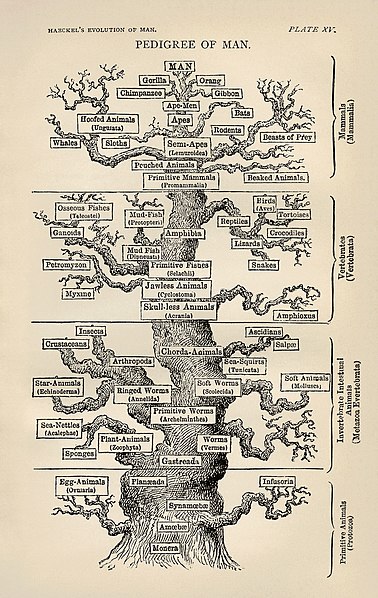In this episode of Discovering Darwin we discussed the fifth chapter of
Origin of Species titled Laws of Variation. Ironically there are no laws actually discussed in the chapter but Darwin does outline a variety of phenomenon and patterns of inheritance and variation that puzzled and intrigued him. When we consider the great variation in forms that we see in nature it is often difficult to tease apart the cause of that difference in form. For example, variation in form may be genetically determined as described by Mendel and his experiments with pea plants. Of course Darwin did not have a sense of genes and how multicellular plants (excluding mosses) and animals get two copies of each gene, one form their mother and one from their father, that codes for traits. Those two copies of the genes determine the expression of physical traits. Looking at the chart below of Mendel's pea plant traits you can see how variable the sweet pea plant could be.

Imagine Darwin's confusion if he saw pea plants with yellow or green seeds, purple or white flowers and variation on where the flowers are located on the plant. Even more intriguing is the notion that yellow seeded pea plants with purple flowers could be crossed and produce offspring with green colored pea seeds and white flowers! Today, with our knowledge of genetics, we understand the concept of recessive and dominant traits and how recessive traits can be hidden in the parents but expressed in the offspring when they inherit only the recessive versions of the gene.
We discussed if Darwin actually was aware of Mendel's work and Josh mentioned an interesting paper by Bizzo and El-Hani that argued Darwin was aware of Mendel's work. That paper can be found
here.
Acclimation versus Adaptation
Sarah discussed how Darwin seemed to use the terms acclimation and adaptation interchangeably as he worked through his understanding of how organisms can exhibit variation in form. Today biologists see these two concepts as separate and unique characteristics.
Some of the best examples of
acclimation can be seen in arctic animals, like this arctic fox, that can dramatically change their coats from winter to summer.
Acclimation is when the organism alters its form, physiology or behavior in response to local environmental conditions. Often these changes are induced by hormonal changes in the organism which themselves are triggered by environmental stimuli. These changes are typically not permanent.
In contrast, if you look at a population of a species you may see variation in forms but these are adaptations to local conditions. An interesting example of local
adaptations is seen in the north American rock pocket mouse (
Chaetodipus intermedius) that lives in the southwest desert areas of US and Mexico. This small, bite sized rodent, lives in a variety of rocky habitats which differ in color depending upon the geological history. The brown sandy colored rocks are in contrast to the black balsaltic rock that formed from geologically recent lava flow events. The mice have strong local selection to avoid being seen by their natural predators so selection favors coat colors that blend with the background. The top two images are showing the local mouse in its native local condition, the bottom two panels are swapping mice from their native locations. All of these mice are the same species but their coat color variation is genetically determined by expression of Mc1r gene for black pigmentation and that gene has undergone local mutations and selection.
We also discussed how creatures locally adapt to caves by losing the ability to see and often become pale colored or completely lose their coloration. Josh read a wonderful quote by Darwin where he described blind cave crabs possessing components of the eye but it was incomplete in form.
 |
| Image from http://imgarcade.com/1/blind-cave-crab |
We also discussed how Darwin recognized the pattern that certain traits correlated with individual sexes but did not understand how that was possible. Darwin spoke of calico cats and how he was puzzled that they are typically only female. Of course we now understand that sex is determined by sex chromosomes and traits can be sex-linked when they are located on the sex chromosome, which in mammals are called X and Y chromosomes (females are XX, males are XY).A very nice summary of the genetics of calico cats can be found
here.
 |
| image from Wikipedia |
During the podcast we discussed Darwin's critique of the idea that every unique species was individually specially created by a Creator. Darwin mentioned how improbable it was that the creator would take the time to make different varieties of turnips. This discussion stimulated a flashback for Josh to remember when he was an undergraduate seeing outside a professors office a classic Farside cartoon concerning special creation. "Oh my, me...."
 |
| copyright Gary Larson |
Modern View of Inheritance and Sources of Genetic Variation
In contrast to Darwin's semi-blending model of inheritance, biologist today rely on the particulate model of inheritance, which is based on the idea that individuals gain specific set of genetic particles (chromosomes) from both their parents. We now understand that the process of sexual reproduction creates great variation in offspring without relying solely on the process of genetic mutations to create new forms.Yes genetic mutations are important in creating new traits (see mouse story above) but much of the genetic variation we see in nature
within a generation derives from shuffling and recombining preexisting traits when creating gametes (eggs and sperm) and combining those gametes (fertilization) into a new individual.
To illustrate how variation is created through sexual reproduction allow me to use an analogy where playing cards represent genetic information. Imagine you take a complete deck of cards sans the joker and partition them out such that you have all the heart and spade suits and your reproductive partner has all the diamonds and club suits. The red colored suits (diamonds and hearts) represent the original genetic material inherited from your mother's side and the black suits (clubs and spades) denote the original genetic material inherited from the father's side. Each of these cards would signify a chromosome, a strand of DNA that has a variety of genes which code for traits. Since you would have two copies of each chromosome - a heart and spade set of ace, 2, 3, 4, 5, 6, 7, 8, 9, 10, jack, queen and king - you are considered a diploid (di - two) individual. So is your reproductive partner who has the diamond and club suit of the same cards. In this example you would have a total chromosome count of only 26 where in reality humans have a total chromosome count of 46 but this simplified example will illustrate how inheritance and a majority of the variation occurs.
 |
| Your diploid genome - 1/2 the genetic material from your dad, 1/2 from your mom. |
When you go to reproduce sexually you make gamete cells, either sperm or eggs depending upon your biological sex. To make those cells you randomly draw a single card from either the heart or spade suit to create a cell that has only one copy of each card - ace through king. This new cell would have a chromosome count of only 13, half of what you have, and is called a haploid cell. Your partner is doing the same thing with their cards, creating a haploid cell that contains ace through king cards randomly chosen from the diamond and club set they contain. When those two haploid cells fuse, a process called fertilization, you recreate a diploid individual who has two copies of each of the cards ace through king. So in sexual reproduction it is a reduction in total genetic material (in haploid gametes) and then a reconstitution of the total genetic material during fertilization.
The traits encoded in the genes on the chromosome, represented by the playing cards, get passed from parent to offspring as intake distinct "particles". Variation is also created in this process because when the gametes are formed the single chromosome donated to the cell came about from randomly drawing from the two possible sources. Imagine you are actually flipping a coin to decide which card to choose with the rule that heads picks the red card and tails picks the black card. You could randomly draw all the red cards to make your gamete, improbable but not impossible. It would require flipping 13 heads in a row which for a fair coin the probability of occurring is 1 out of 8192 times. Improbable but not impossible. The inverse is true for drawing only black cards. Most likely the gamete would contain a mixture of red and black cards for the ace through king cards. But even then, you could create a large number of possible combinations of just those thirteen cards - 8192 to be exact. You then repeat the process for the other gamete and it is easy to see how many different combinations of chromosome pairs the new fertilized gamete can contain. This process of creating genetic variation through random drawing of each chromosome is called
independent assortment, that is each chromosome independently assorts into the gamete cell.
 |
| One of 8192 possible haploid gametes you could make |
As you imagine all the probable outcomes of creating this gamete it becomes clear that you could create a great diversity of gametes - in humans with 23 pairs of chromosomes you can create 2
23=8,388,608 genetically different gametes! On top of this source of variation, there is also a phenomenon called
crossing over where two sister chromosomes - in our example imagine two of the cards of the same value, e.g., the queen cards - break apart and recombine with each other. So take your queen of hearts and queen of spades, stack them together, rip them randomly in two and then tape the two opposite colored halves back together to create a queen card that now has top half red and bottom half black and the other card is the inverse, top half black and bottom half red. This would then allow traits on one chromosome to be combined with traits on a completely separate chromosome so they are now being inherited together. Assuming these traits were housed on the same chromosome, which is not true, imagine grandma had brown eyes and was farsighted, whereas grandpa had blue eyes but had normal vision and all of these traits were on the same chromosome. Now with crossing over, we have a chromosome with grandmas brown eyes and grandpas normal vision and grandpas blues eyes now combined with farsightedness.
 |
| A crude approximation of crossing over creating two new chromosomes. |
As you can see with
crossing over and
independent assortment occurring you can appreciate the great array of genetic diversity that can be created in the offspring during sexual reproduction.
The
opening and closing theme to Discovering Darwin is "May" by Jared C. Balogh.
http://freemusicarchive.org/music/Balogh/Revitalized_Eyes/MAY
Copyright: Attribution-NonCommercial-ShareAlike:
http://creativecommons.org/licenses/by-nc-sa/3.0/
Interlude music if Frenchy's String Band "Sunshine Special" recorded in Texas sometime around 1927. https://archive.org/details/FrenchysStringBand-SunshineSpecial





































 This figure is from the Smithsonian and is an interactive figure at their
This figure is from the Smithsonian and is an interactive figure at their 
